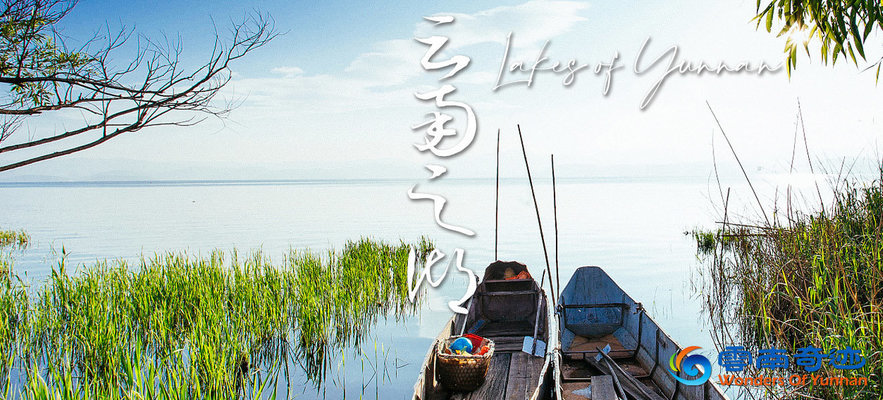Yunnan has many beautiful sceneries and is famous for her mountains, ethnic minority tribes and perfect climate. But as the Chinese idiom “有山有水” (yǒu shān yǒu shuǐ) describes, the perfect sceneries “have mountains, have water”. Without curling rivers and tranquil lakes, Yunnan’s landscape would lose a lot of her charm. You wouldn’t be able to hike one of the world’s most spectacular river canyons without the Jinsha River cutting through the Tiger Leaping Gorge in Shangri-La. Dali Old Town would not be the magical land that everyone loves without Erhai Lake, and Kunming would be deprived of her most stunning panorama views from the cliffs of the Western Hills without Dianchi Lake.
So let’s take a look at the lakes of Yunnan that add the “shuǐ” to Yunnan’s “shān”, or in English add water to Yunnan’s mountains. There are many famous lakes in Yunnan Province, but these are the nine biggest ones.
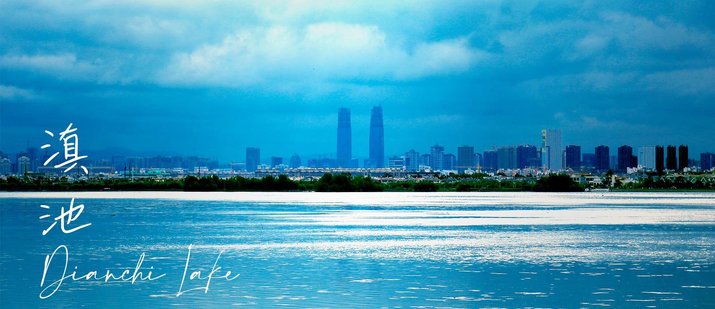
1. Dianchi Lake
| Chinese Name | 滇池 |
| Pinyin | Diānchí |
| Name Meaning | Yunnan Lake |
| Location | Kunming Prefecture, south of Kunming City |
| Ranks |
1st largest lake in Yunnan 8th largest lake in China |
| Length (N-S) | 40 km | 25 miles |
| Average width (W-E) | 7 km | 4.4 miles |
| Maximum width (W-E) | 12 km | 7.5 miles |
| Shore length | 150 km | 93 miles |
| Area | 330 km2 | 127 mi2 |
| Drainage area | 2,920 km2 | 1,127 mi2 |
| Surface elevation | 1,886 m | 6,188 ft |
| Maximum depth | 10 m | 33 ft |
| Average depth | 4.4 m | 14 ft |
| Av. annual water resource | 570 million m3 | 462,107 acre feet |
| Volume | 1.29 billion m3 | 1.05 billion acre feet |
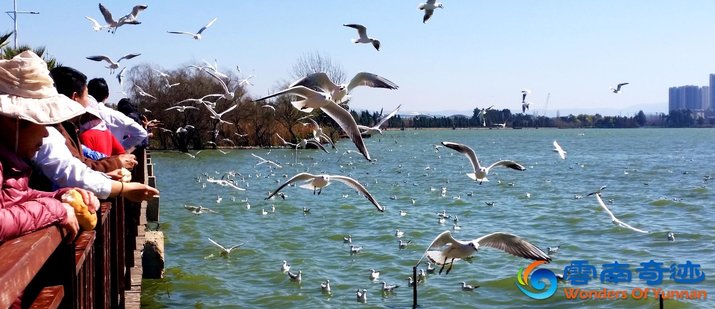 Dianchi Lake is a popular place for Kunming residents to spend their free time, especially in winter when they go to feed the the Siberian seagulls wintering at the lake
Dianchi Lake is a popular place for Kunming residents to spend their free time, especially in winter when they go to feed the the Siberian seagulls wintering at the lake
There are different theories what the origin of the name Dianchi is. The most accepted theory is that the name Dianchi (chí simply means “pool” or “pond”) comes from the first ancient kingdom that was established around the lake around 279 BC. The kingdom was called Dian and the people called the lake “Dian Pond”. 170 years later in 109 BC, the kingdom surrendered to Emperor Wu of the Han people that colonised the whole area. Later the area became Yunnan and the character 滇 dian became a synonym and abbreviation for Yunnan province.
Dianchi Lake is the largest lake in Southwest China and the eighth biggest lake in China. It was once known as “Pearl of the Highlands”.
The lake is alternatively also called Kunming Lake, and the famous Kunming Lake in the Summer Palace of the emperor in Beijing was called after it.
As one of the biggest freshwater lakes in Asia, it no surprise that people settled here and Kunming became a thriving city. Unfortunately nowadays, Dianchi Lake is infamous in China for being one of the most polluted lakes, which was an inevitable consequence of the advance of society in Kunming as it became the city’s sewage dump. On the bright side, since the beginning of the 21st century, the Chinese government has started programs to fight pollution all over the country, and the water quality of Dianchi Lake has improved significantly and the colour changed from algae green to clear blue again.

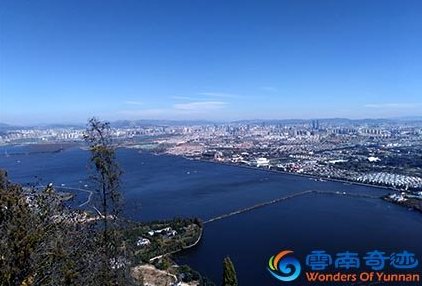 Two photos taken by me from the Western Hills' Dragon Gate. On the left Dianchi Lake is green from pollution in 2013. Photo on the right taken in 2019, the water blue and a lot cleaner than six years earlier.
Two photos taken by me from the Western Hills' Dragon Gate. On the left Dianchi Lake is green from pollution in 2013. Photo on the right taken in 2019, the water blue and a lot cleaner than six years earlier.
Read more about Dianchi Lake history, geography and attractions around it
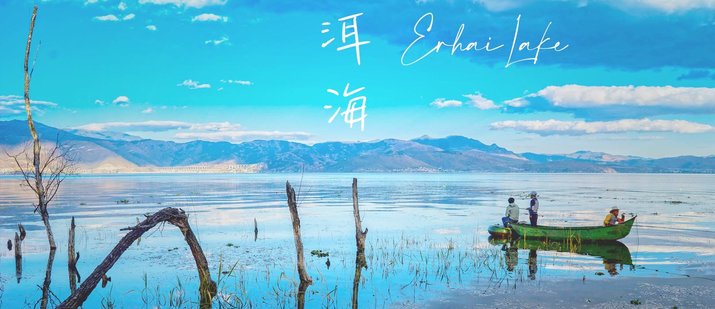
2. Erhai Lake
| Chinese Name | 洱海 |
| Pinyin | Ěrhǎi |
| Name Meaning | Ear Sea |
| Location | Dali Bai Autonomous Prefecture, Dali County |
| Ranks |
2nd largest lake in Yunnan |
| Length (N-S) | 42 km | 26 miles |
| Width (W-E) | 7-8 km | 4-5 miles |
| Shore length | 117 km2 | 73 miles |
| Area | 251 km2 | 97 mi2 |
| Drainage area | 2,565 km2 | 990 m2 |
| Surface elevation | 1,972 m | 6,470 ft |
| Maximum depth | 22 m | 72 ft |
| Average depth | 11 m | 36 ft |
| Av. annual water resource | 825 million m3 | 668,839 acre feet |
| Volume | 2.95 billion m3 | 2.39 million acre feet |
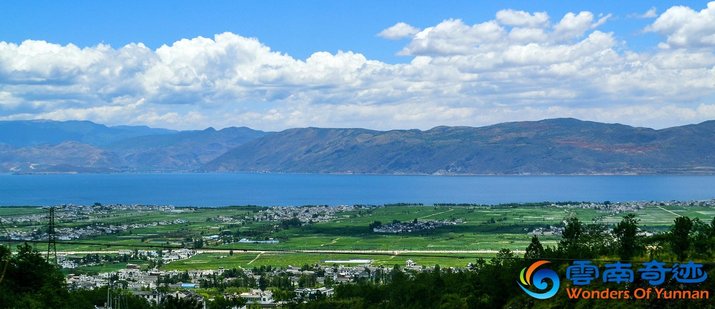 View over Erhai Lake and Dali countryside from the Cangshan mountains back in 2013
View over Erhai Lake and Dali countryside from the Cangshan mountains back in 2013
Dali’s Erhai Lake is the second largest lake in Yunnan province. The lake lies in an idyllic valley, where it together with the endearing Cangshan Mountains surrounds Dali Old Town, which used to be the seat of the ancient Nanzhao Kingdom.
The stretched lake that was the cradle of flourishing civilizations had several names during ancient times, such as Xieyu River (叶榆河, harmonious elm river), Xieyu Pond (叶榆泽), Xi’er River (西洱河, western ear river), Er River (洱河) and Kunmi River (昆弥川) before it was finally named Erhai meaning Ear Sea.
When looking at a map, you can tell that the ear part of the name comes from the shape that kind of looks like a human ear. But how did the lake go from being a river to being a sea? Well, it is one of the Eighteen oddities of Yunnan that locals are quite proud of, that it is custom that lakes in Yunnan are called sea.
The picturesque Dali Old Town in the Erhai basin has long been a paradise for both off-the-beaten track wanderers and dreamy artists. But where Dali used to be known as the ultimate uncharted backpackers paradise, it has become more and more popular with domestic tourists. Hotels popped up like weeds around the lake and especially directly at the lakeside, because who doesn’t want to get away from the stressful city life at the shores of this perfect serene lake in this enchanting land?
If that sounds inviting to you, well, you’re out of luck. Since 2017, the government has temporarily closed all hotels within 50 meter of the lake to protect the ecological environment and within 100 meter of Erhai Lake, no construction is allowed. Since 2019 even fishing in the lake has been banned all year round. This hasn’t stopped the flow of tourism, but it did help improve the ecosystem of Erhai Lake.
But Dali just seems to be a place where no matter how much commercialization happens and even if you cannot overnight at the lake shore, it will always retain that pure energy it has always had, if you only allow yourself to look see it.
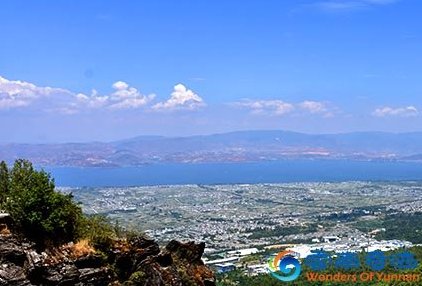
 More recent views over Dali country and Erhai Lake from the Cangshan Mountains, photos made in 2018, the valley is completly filled with buildings and is no more the off-the-beaten-track paradise it once was. It doesn't take away that Dali and Erhai Lake are still a paradise to relax and spend a calm weekend
More recent views over Dali country and Erhai Lake from the Cangshan Mountains, photos made in 2018, the valley is completly filled with buildings and is no more the off-the-beaten-track paradise it once was. It doesn't take away that Dali and Erhai Lake are still a paradise to relax and spend a calm weekend
Read more about the enchanting Erhai Lake
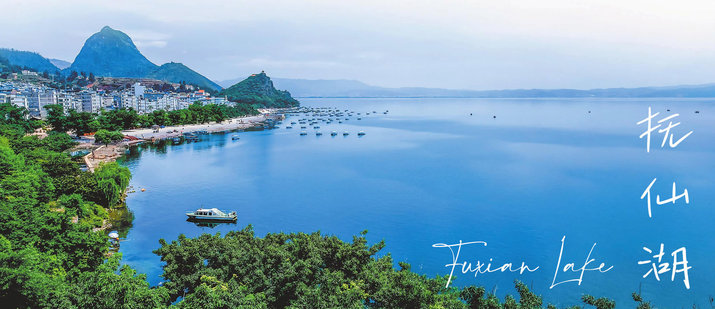
3. Fuxian Lake
| Chinese Name | 抚仙湖 |
| Pinyin | Fǔxiān Hú |
| Name Meaning | Comforting Fairies Lake |
| Location | Yuxi Prefecture, Chengjiang, Jiangchuan and Huaning Counties |
| Ranks |
3rd largest lake in Yunnan 1st deepest lake in Yunnan 1st largest volume lake in China 3rd deepest freshwater lake in China |
| Length (N-S) | 31 km | 19 miles |
| Maximum width (W-E) | 12 km | 7.5 miles |
| Shore length | 101 km | 63 miles |
| Area | 216 km2 | 83 mi2 |
| Drainage area | 675 km2 | 261 mi2 |
| Surface elevation | 1,722 m | 5,650 ft |
| Maximum depth | 159 m | 522 ft |
| Average depth | 95 m | 312 ft |
| Av. annual water resource | 167 million m3 | 135,390 acre feet |
| Volume | 20.6 billion m3 | 1.67 million acre feet |
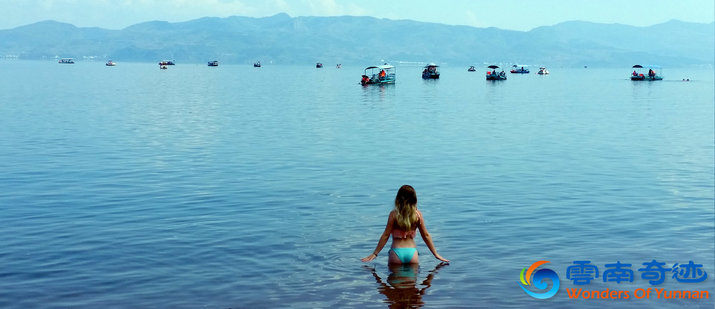 Back in 2016 it was still possible to go swimming and boating in Fuxian Lake, as one of the cleanest lakes in Yunnan. Unfortunately - but understandably - to protect the lake's natural ecosystem swimming, boating and fishing are not allowed anymore
Back in 2016 it was still possible to go swimming and boating in Fuxian Lake, as one of the cleanest lakes in Yunnan. Unfortunately - but understandably - to protect the lake's natural ecosystem swimming, boating and fishing are not allowed anymore
Known as “Big Pool” at first and later called “Luojia Lake” after the Luojia tribe living in Chengjiang during the Tang (619 - 907) and Song (960 - 1279) Dynasties, the lake eventually was called after a legend. The Jade Emperor of the Chinese Heavens sent two fairies to the mortal world for patrol, but once they arrived in central Yunnan, they stumbled upon a pool of astonishing beauty. The lake had such clear water and sparkling waves, that they became so mesmerized that they could just stand side by side staring at the lake and forgot to return to the Heavens. The fairies put their hands on each other’s shoulders and eventually turned into stone, looking out over the lake for all eternity. The myth of Fuxian lake isn’t finished. Later a legendary duel took place between a dragon and an immortal, and the city Chengjiang got hit so badly, it fell into the lake.
There might not really have been a legendary fight involving a dragon at the lake, but Fuxian Lake does have its own Atlantis including a Maya style pyramid hidden below the water surface. This ancient underwater city of a lost civilization was discovered by a diver in the nineties and has since been researched. Relics have been dated roughly 1,750 years old and it is thought that ancient city from the Dian Kingdom slid into to lake during an earthquake.
As one of the least polluted lakes in Yunnan and even in China, Fuxian Lake is home to several endangered endemic fish species but at the same time an exceptionally popular tourist spot. It used to be one of the few lakes where you could still swim and go boating, but since a few years the government has banned swimming and recreational boats in the lake to protect the ecological environment and prevent pollution. It is possible to go scuba diving in Fuxian Lake, including a visit to the Lost City, though foreigners need to apply in advance with the government for a permit (which we are happy to help with!).
Fuxian Lake is shrouded in mystery, and famous in the whole of China. When in 2001 CCTV live broadcasted an underwater research to the sunken city, the popular broadcast was suddenly stopped after 40 minutes, and left everyone guessing what they had found and wanted to hide...
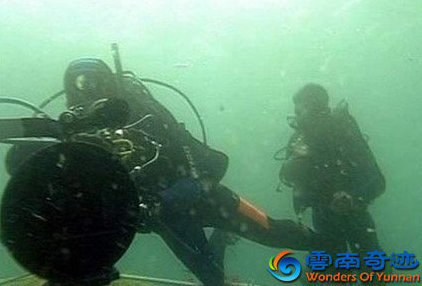
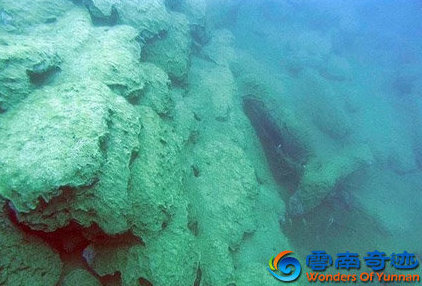 Left: divers are exploring and researching the underwater ruins found at the bottom of Fuxian Lake. Right: an ancient stone wall found said to be from an ancient civilization
Left: divers are exploring and researching the underwater ruins found at the bottom of Fuxian Lake. Right: an ancient stone wall found said to be from an ancient civilization
Read more about lakeside tourist hotspots and the 8 mysteries of Fuxian Lake
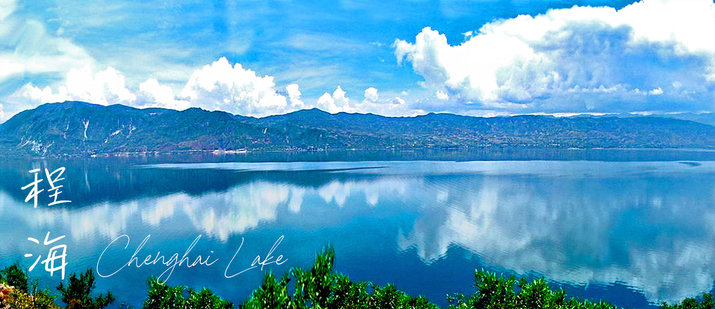
4. Chenghai Lake
| Chinese Name | 程海 |
| Pinyin | Chénghǎi |
| Name Meaning | Cheng Sea |
| Location | Lijiang Prefecture, Yongsheng County |
| Rank |
4th largest lake in Yunnan |
| Length (N-S) | 18 km | 11 miles |
| Width (W-E) | 4.5 km | 2.8 miles |
| Shore length | 45 km | 28 miles |
| Area | 77 km2 | 30 mi2 |
| Drainage area | 424 km2 | 164 mi2 |
| Surface elevation | 1,497 m | 4,911 ft |
| Maximum depth | 35 m | 115 ft |
| Average depth | 26 m | 85 ft |
| Av. annual water resource | 112 million m3 | 98,907 acre feet |
| Volume | 1.99 billion m3 | 1.61 million acre feet |
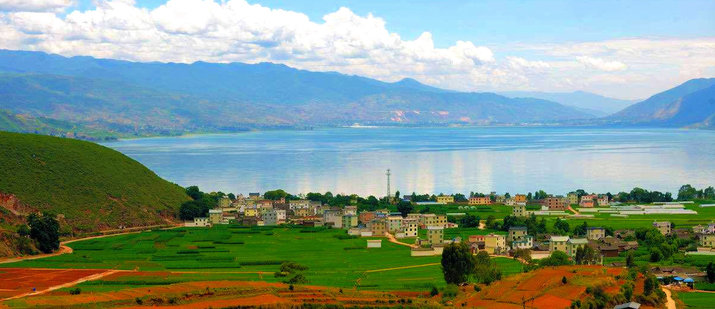 Chenghai is located in the dry and hot Jinsha River Valley in Lijiang
Chenghai is located in the dry and hot Jinsha River Valley in Lijiang
The name and characters of Chenghai Lake have been recorded as early as the Ming Dynasty (1368 - 1644). According to ancient records, the land used to be dry and inhabited by a clan named Chen (陈) but the land turned into a “sea” overnight, hence the name Chenghai, in which the Chinese character cheng later changed from 成 to 程 (成海 and 程海 are both pronounced chénghǎi, 成海means to become a sea, both sound very familiar to the clan name 陈 Chén). But historians think the name is also derived from the Yi minority clans inhabiting the area during the Ming Dynasty called Chen (陈) and Hai (海).
The lake is notable for being only one of the three lakes in the world where you can naturally find the cyanobacteria (blue-green algae) Spirulina (Arthrospira platensis). These algae are used as a dietary supplement or wholefood and is a feeding supplement in the aquaculture and poultry industry. That these cyanobacteria grow only in Chenghai lake is due to the unique environment of Chenghai Lake. Chenghai lies in the Jiansha River valley, which is hot but dry and with plenty of sunshine. Since 1980 the water level of the lake has been declining, creating a more alkaline environment. Now the pH level of Chenghai lies around 9 and with high ion, sodium, magnesium and sodium bicarbonate levels, the environment is very different from the other plateau lakes and makes a beneficial habitat for Spirulina. Every summer, the lake turns cloudy and muddy, with green powdered foam and sometimes it colours exactly like rice water for about ten days. Thus, the locals call it “fragrant noodle water”.
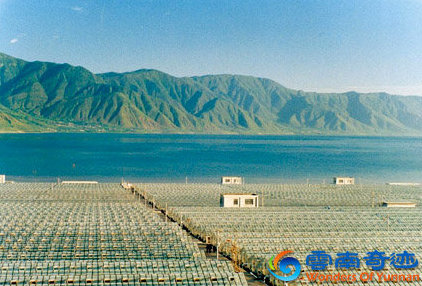
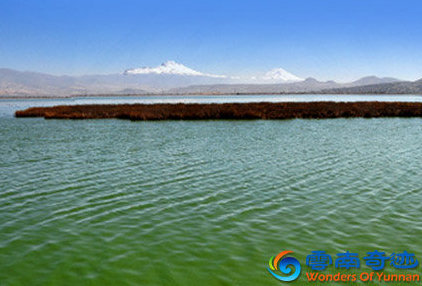 Spirulina grows in many lakes around the world, but only in 3 they occur naturally. On the left a spirulina farm at the banks of Chenghai lake in Lijiang. On the right cloudy green water of Chenghai lake.
Spirulina grows in many lakes around the world, but only in 3 they occur naturally. On the left a spirulina farm at the banks of Chenghai lake in Lijiang. On the right cloudy green water of Chenghai lake.
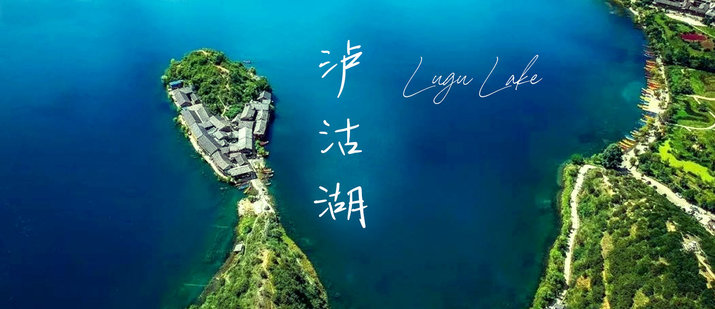
5. Lugu Lake
| Chinese Name | 泸沽湖 |
| Pinyin | Lúgū Hú |
| Name Meaning | Yunnan Lake |
| Location |
Lijiang Prefecture, Ninglang Yi Autonomous County Sichuan Province, Yanyuan County |
| Ranks |
5th largest lake in Yunnan |
| Length (N-S) | 9.5 km | 5.9 miles |
| Width (W-E) | 5.2 km | 3.2 miles |
| Maximum width (W-E) | 7.5 km | 4.6 miles |
|
Shore length Yunnan shore length |
44 km 22 km |
27 miles 13.5 miles |
|
Area Yunnan area |
50 km2 27 km2 |
19 mi2 10 mi2 |
|
Drainage area Yunnan drainage area |
248 km2 107 km2 |
96 mi2 41 mi2 |
| Surface elevation | 2,685 m | 8,809 ft |
| Maximum depth | 105 m | 344 ft |
| Average depth | 40 m | 131 ft |
| Volume | 2.28 billion m3 | 1.82 million acre feet |
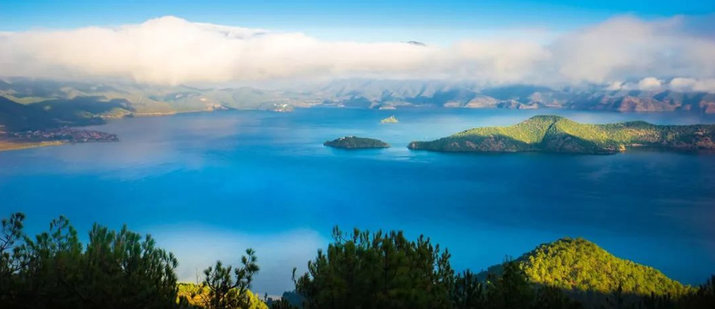 Some say that Lugu Lake is the most beautiful lake in China
Some say that Lugu Lake is the most beautiful lake in China
One of the most famous lakes in Yunnan is without doubt Lugu Lake, shared with Sichuan province. Outside of China, Lugu Lake is probably most known for the Mosuo tribes living around the lake who live in one of the last matrilineal societies left on earth and Lugu Lake is often called “the Kingdom of Women”. A woman is the head of the household, which consists of the matrilineal family, including children, sisters, brothers, nieces, nephews, grandchildren etc. There is no marriage, casual or long-lasting partnerships are formed by the man visiting the woman’s bedroom at night, returning to his maternal home in the morning. Children will be raised by the mother’s family and the father can play a major or minor roll in the raising. It is not uncommon that uncles play a father’s role in the child’s life.
In the language of the Mosuo, 泸 lú means valley and沽gū means inside, and so the name Lugu Lake means Lake inside the valley. In ancient times it was known as Lede Sea, Luku Lake (rough and dry Lake), Zuosuo Sea (after a tribe’s name in Yuan, Qing and Mind Dyansties) and Liang Sea (Bright Sea).
Next to the Mosuo minority, there are also Mongolian, Yi, Naxi, Tibetan, Pumi and Bai minorities living around the lake.
Since Lugu Lake became a national key scenic spot in 1988, tourism has developed quickly in the area. Tourism has become an incredibly important income for Lugu Lake and lifted many Mosuo families out of poverty. Even though in the eyes of some a lot of the authentic Mosuo culture is disappearing, many Mosuo people are happy to have an income to feed their families and to modernize their life and the lake’s fish won’t be exploited.
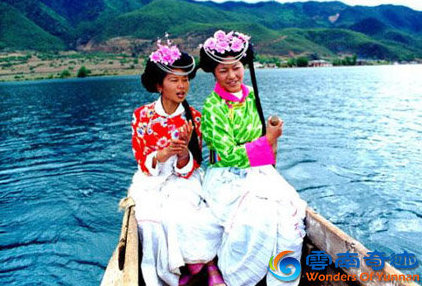
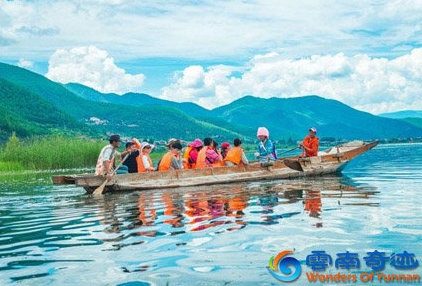 You will find many canoes and boats on Lugu Lake. The local Mosuo minority used to use them for fishing. Nowadays, they are mostly used for taking tourists on boating trips. It might feel less authentic for some, but it is a much better income for the locals than fishing and better for the lake's ecosystem
You will find many canoes and boats on Lugu Lake. The local Mosuo minority used to use them for fishing. Nowadays, they are mostly used for taking tourists on boating trips. It might feel less authentic for some, but it is a much better income for the locals than fishing and better for the lake's ecosystem
Read more about Lugu Lake history, culture and tourism
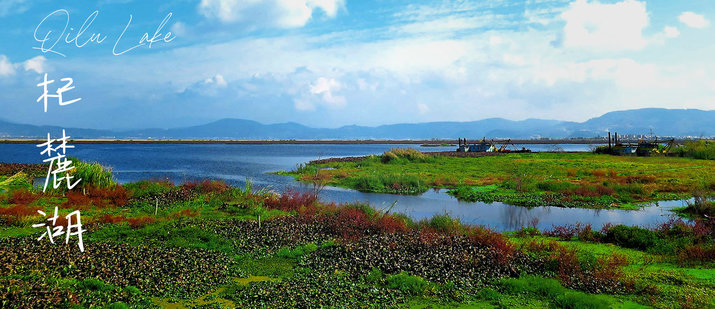
6. Qilu Lake
| Chinese Name | 杞麓湖 |
| Pinyin | Qǐlù Hú |
| Name Meaning | Willow at the foot of the hill Lake |
| Location | Yuxi Prefecture, Tonghai Cou8nty |
| Rank |
6th largest lake in Yunnan |
| Length (SW-NE) | 13.5 km | 8.4 miles |
| Average width (NS-SE) | 2.7 km | 1.7 miles |
| Maximum width (NW-SE) | 5.2 km | 3.2 miles |
| Shore length | 45 km | 28 miles |
| Area | 37 km2 | 14 mi2 |
| Drainage area | 341 km2 | 132 mi2 |
| Surface elevation | 1,797 m | 5,896 ft |
| Maximum depth | 6.8 m | 22 ft |
| Average depth | 4 m | 13 ft |
| Volume | 145 million m3 | 117,554 acre feet |
 Qilu lake has a dense plant population and has several wetlands around the lake
Qilu lake has a dense plant population and has several wetlands around the lake
Qilu Lake used to be called Haihe in the Tang Dynasty (618 - 907), meaning “Sea River” and later it got the name Tong Lake after the county name Tonghai. In the Yuan Dynasty (1271 - 1368) the water level of the lake rose all the way up to the foot of the Qilu Mountain which is also known as Mount Xiu nowadays, and the lake’s name was changed to Qilu Lake.
The locals call Qilu lake the “Mother Lake”, due to its economic and social importance for Tonghai County. About 90% of the county’s population lives in the lake basin.
The lake is a eutrophic lake, meaning it is incredibly rich in nutrients and supports a dense plant population, resulting in murky, green water and mucky bottoms. Another result from eutrophication is organic, nitrogen and phosphorus pollution, algae blooms and a lower oxygen level making it a hard environment for fish to survive. The aboriginal fish population is very simple, but in the 60s people began introducing new fish species to boost the economy of the lake. Many native fish specie populations declined and became endangered.
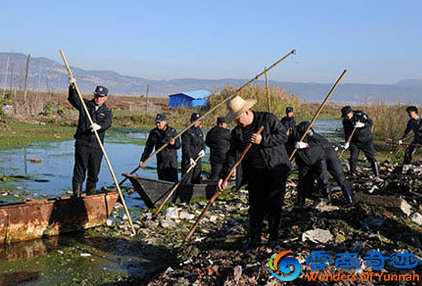
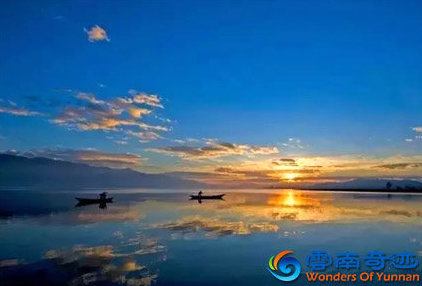 Left: the government startie programs to clean up Qilu Lake in 2015. Right: this is the view of Qilu Lake that we all want!
Left: the government startie programs to clean up Qilu Lake in 2015. Right: this is the view of Qilu Lake that we all want!

7. Xingyun Lake
| Chinese Name | 星云湖 |
| Pinyin | Xīngyún Hú |
| Name Meaning | Star Cloud Lake |
| Location | Yuxi Prefecture, Jiangchuan District |
| Rank | 7th largest lake in Yunnan |
| Length (N-S) | 10.5 km | 6.5 miles |
| Maximum width (W-E) | 3.8 km | 2.4 miles |
| Shore length | 36 km | 22 miles |
| Area | 35 km2 | 13.5 mi2 |
| Drainage area | 378 km2 | 146 mi2 |
| Surface elevation | 1,722 m | 5,650 ft |
| Maximum depth | 10 m | 33 ft |
| Average depth | 6 m | 23 ft |
| Av. annual water resource | 85.5 million m3 | 69,316 acre feet |
| Volume | 184 million m4 | 149,171 acre feet |
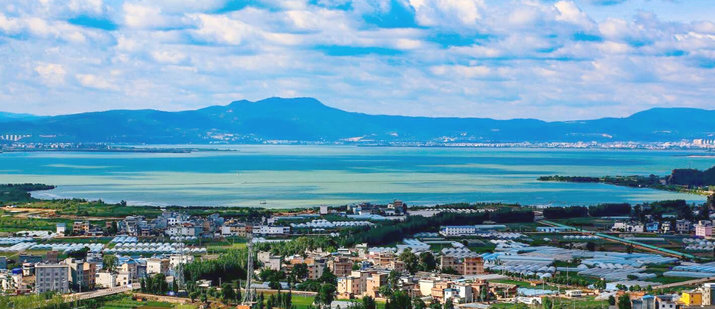 Panorama view of the clear Xingyun Lake in Yuxi Prefecture
Panorama view of the clear Xingyun Lake in Yuxi Prefecture
Xingyun Lake is the upstream lake of Fuxian Lake, which lies just south of Fuxian Lake with only one mountain separating the two lakes. Because the lake is so calm and crystal clear that it mesmerizes people and on clear nights the sky get reflected on the lake like starry clouds, hence the name Xingyun Lake.
The calmness of Xinyun Lake and its many bays makes it very suitable for aquaculture and fishing and is famous for its high fish output. It was one of the first places for professional breeding of fish cultures in Yunnan. The lake is home to 20 main fish species, including many carp species and the Jiangchuan Bighead Carp (Aristichthys nobilis), which is one of the most important species in aquaculture worldwide, but especially popular in China for its juicy fat meat and rich flavour.
On the 25th of December the fishing season at Xingyun Lake starts, which is celebrated with the Fishing Festival (开渔节). On this day the shore will be full with lined up fishing boats decorated with red silk embroidered balls and long firecrackers. At the sound of a gun salvo, fishers, donned in their best and newest outfits, will light the crackers on the boats at the same time and sail out to cast their fishing nets. In Jiangchuang district and the villages around the lake there will be street markets full of fish.
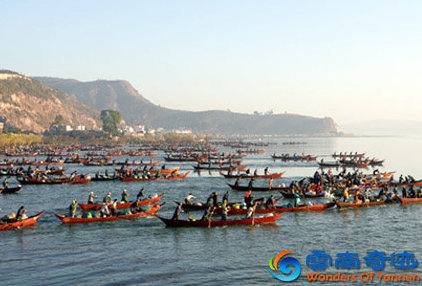
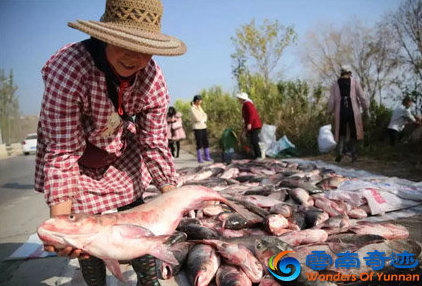 Left: fishing boats sail out together during the Fishing Festival at Xingyun Lake on the 25th of December. Right: During the festival, the streets are full with markets selling fish
Left: fishing boats sail out together during the Fishing Festival at Xingyun Lake on the 25th of December. Right: During the festival, the streets are full with markets selling fish

8. Yangzong Lake
| Chinese Name | 阳宗海 |
| Pinyin | Yángzōng Hǎi |
| Name Meaning | Sun’s Clan Lake |
| Location | Kunming Prefecture, Yiliang County |
| Rank |
8th largest lake in Yunnan |
| Length (N-S) | 12.5 km | 7.8 miles |
| Maximum width (W-E) | 3 km | 2 miles |
| Shore length | 32 km | 20 miles |
| Area | 31 km2 | 12 mi2 |
| Drainage area | 192 km2 | 74 mi2 |
| Surface elevation | 1,770 | 5,807 ft |
| Maximum depth | 30 m | 98 ft |
| Average depth | 22 m | 72 ft |
| Av. annual water resource | 52 million m3 | 42,157 acre feet |
| Volume | 617 million m3 | 500,210 acre feet |
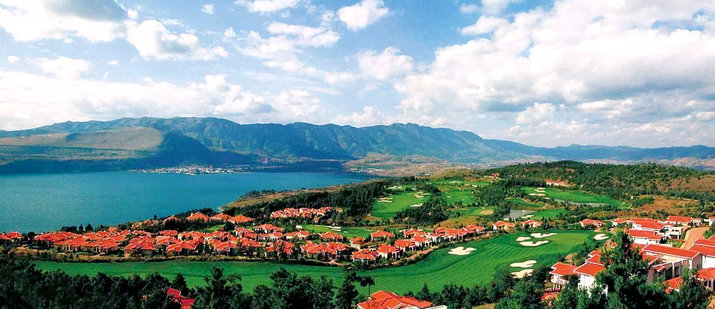 There are many resorts around Yangzong Lake, including the award winning and world famous Spring City Golf and Lake Resort
There are many resorts around Yangzong Lake, including the award winning and world famous Spring City Golf and Lake Resort
Yangzong Lake is only 36 kilometers away from Kunming. Ancient names of Yangzong Lake are Big Pond in the Yuan Dynasty (1271 - 1368), with the nick name “hot pool” for the hot springs in the area. Later it was mentioned as Yixiu Lake and in the Ming Dynasty it was called Ming Lake (1368 - 1644). Eventually it was called after a clan from the Nanzhao Kingdom of Dali called Qiangzong, that took the region and settled with a thousand households. Qiangzong eventually changed to Yangzong.
Yangzong Lake too has been through periods of heavy pollution, the worst being in 1997 after which the government took measurements to improve the water quality. In 2002 the water quality of the lake had been declared being clean enough for drinking and swimming. But in 2008 it was unfit for drinking, swimming and fishing again, being polluted with arsenic. The Kunming Communist Party Secretary stated the lake mustn’t become a second Dianchi Lake, and found that 8 companies had been illegally polluting the lake. Three executives of a company were arrested and 12 government officials were fired over the Yangzong Lake pollution case. In 2015 the water had been classified as “slight pollution of water quality”.
At the lake shores you can find many resorts, and it is a popular weekend get-away for those living in Kunming since it is so close to the city. You can also find the Spring City Golf & Lake Resort at Yangzong Lake, according to some the best golf course in China or a close second. It has two championship golf courses that have received over 80 world class awards.
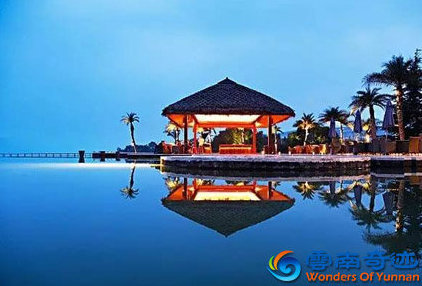
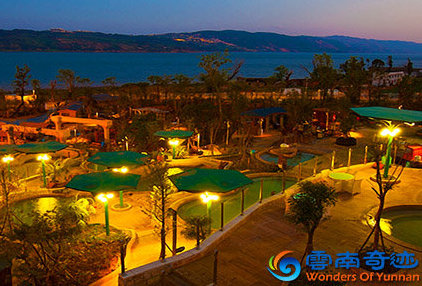 Also for non-golfers there are enough resorts, spas and hotsprings to relax around Yangzong Lake. There even is a water-fun-park for the kids (and those of us adults who want to let out their inner child)
Also for non-golfers there are enough resorts, spas and hotsprings to relax around Yangzong Lake. There even is a water-fun-park for the kids (and those of us adults who want to let out their inner child)
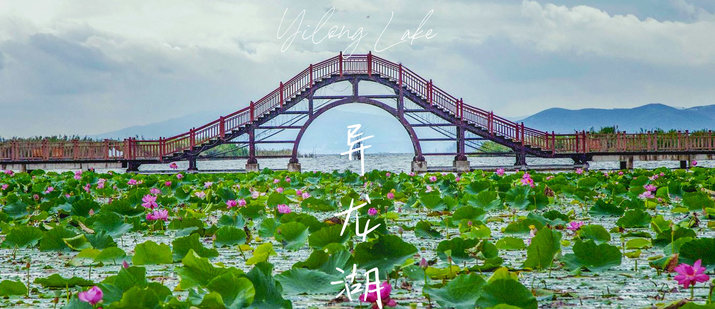
9. Yilong lake
| Chinese Name | 异龙湖 |
| Pinyin | Yì Lóng Hú |
| Name Meaning | Strange Dragon Lake |
| Location | Honghe Hani and Yi Autonomous Prefecture, Shiping county |
| Rank | 9th largest lake in Yunnan |
| Length (W-E) | 15 km | 9 miles |
| Width (N-S) | 33 km | 2 miles |
| Shore length | 75 km | 47 miles |
| Area | 31 km2 | 12 mi2 |
| Drainage area | 360 km2 | 139 mi2 |
| Surface elevation | 1,407 m | 4,616 ft |
| Maximum depth | 6.5 m | 21 ft |
| Average depth | 3 m | 10 ft |
| Av. annual water resource | 44 million m3 | 35,671 acre feet |
| Volume | 113 million m3 | 916,610 million acre feet |
 Yilong Lake is a clear blue lake and is very close to the county seat and very popular with tourists.
Yilong Lake is a clear blue lake and is very close to the county seat and very popular with tourists.
Even though Yilong Lake is the smallest of the 9 big lakes of Yunnan, it is one of the most popular tourist spots in Yunnan. Especially in summer when the lake is full of lotus flowers tourists flock to this lake that is located only 2 km from the country seat. It became an indispensable tourism resource for the area.
The lake used to be known as Yulong Lake, taking its name from the Yulong Mountain south of the lake. The name came from the believe that in 1962 a dragon that lived in the lake ascended to heaven in the daylight.
Like many lakes in Yunnan, but also in China, the lake has suffered a history of pollution. During the sixties the water level declined so much that many spawning sites of endemic fish species were destroyed, leaving them very vulnerable for extinction. In 1981 completely dried up due to water extraction and many of the unique fish species only found in Yilong lake have never been seen again and declared extinct. After the pond was rewatered, the Crucian carp thrived and quickly became the main fish in the lake, now accounting for over 80% of the fish products.
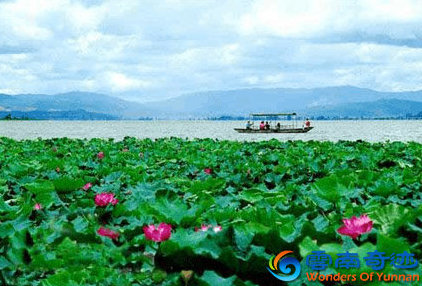
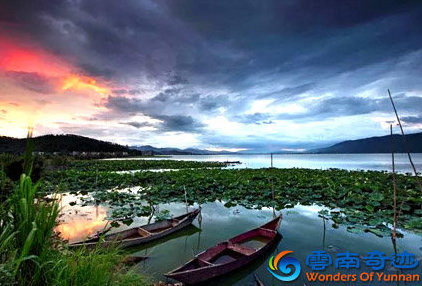 Especially in summer Yilong Lake is very beautiful when lotus flowers are in bloom and many tourists flock here to see the flowers
Especially in summer Yilong Lake is very beautiful when lotus flowers are in bloom and many tourists flock here to see the flowers
- 581 reads
- Like this






